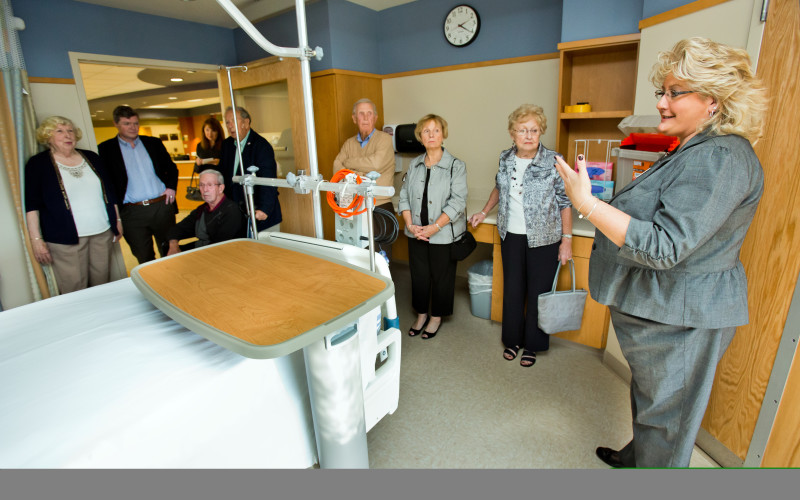Nursing Class of 1954 alumnae tour Wilmington Hospital

In 1954, when Barbara Blair graduated from the nursing program at what would become Wilmington Hospital, there was no intensive care unit or specialized care for psychiatric patients.
“They didn’t cohort patients like they do now,” she recalls. “There was only medical, surgical and maternity — and we took care of them all.”

Sixty years after graduation, Blair and three other nurses from her graduating class — Carole Trent, Janet Lyons and Ruth “Hutch” Staats — returned to Wilmington Hospital for a VIP tour, escorted by Sharon Kurfuerst, EdD, OTR/L, FAOTA, senior vice president of Administration, and Andrew Pack, executive director of Development.
The frieze above the entrance to their former residence on Washington Street remains, and the words ring true today: “Enter to Learn. Go Forth to Serve.”
The nurses’ residence is gone. But their legacy of learning and service shines through in Wilmington Hospital’s $210-million transformation into a 1 million-square-foot, state-of-the-art medical center.
“It’s been a long time since we walked these halls,” Blair said. “What has been accomplished here is remarkable.”
Blair, 81, retired a year ago as executive director of the Epilepsy Foundation of Delaware. Carole Trent of Lewes, 81, worked until a year and a half ago at Beebe Medical Center, where she was a case manager.
The nurses were impressed by the new Center for Advanced Joint Replacement, which logs approximately 2,400 hip and knee replacements each year. All patients have private rooms.
“It’s like a little hotel room,” said Staats, 81, of Claymont.
Kurfuerst showed the nurses a ceiling lift above the bed. “There’s no more manually lifting patients,” she said.
“That is really great,” Blair said. “In our day, back injuries were an occupational hazard.”
Want to learn more? Read the history of Wilmington Hospital.
As they walked the halls of the beautifully renovated hospital, they reflected on how much has changed. In 1954, hospital restrooms and water fountains were segregated, they said. Visiting hours were restricted to a few hours a day, making it difficult for families to spend time with loved ones in the hospital. There was no intensive care unit.
“There were four beds behind the nurses’ station where you had your critically ill patients,” Staats said.
In the 1950s, student nurses lived together in a residence at the hospital, under the watchful eye of a house mother, whose duties included enforcing a 10 p.m. curfew.
“Like every place with a curfew, we used to prop the door open for one another,” Blair said.
Student nurses wore hair nets under their white caps, which would receive a crisp black stripe upon graduation. Lace-up shoes were polished white and uniforms were so crisp they rustled when the nurses walked.
“Starch, straight out of the bottle,” Trent said.
“Our uniforms practically stood up by themselves,” added Blair.
From 11 p.m. to 7 a.m., senior student nurses were the only nurses on duty at the hospital, relying on aides and medical interns for support.
Several perks came with the job. Grads who had babies at the hospital never received a bill.
“And we would always get a private room,” Staats said.
Many of the nurses remained friends through the years. Three raised families in the Ashbourne Hills development in Claymont.
“Because we lived together 24 hours a day for three years, we became a very tight-knit group,” said Janet Lyons, 81, of Fenwick Island.
Today, the space adjoining the former residence has been transformed into a stunning, light-filled atrium.
“Wilmington Hospital is an amazing place, so inspiring,” Blair said. “It’s a true pleasure to see all the wonderful progress that has been made.”